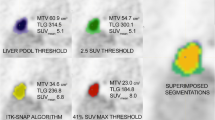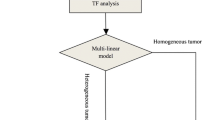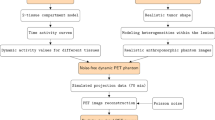Abstract
Purpose
Radiomic features are increasingly utilized to evaluate tumor heterogeneity in PET imaging and to enable enhanced prediction of therapy response and outcome. An important ingredient to success in translation of radiomic features to clinical reality is to quantify and ascertain their robustness. In the present work, we studied the impact of segmentation and discretization on 88 radiomic features in 2-deoxy-2-[18F]fluoro-d-glucose ([18F]FDG) and [11C]methyl-choline ([11C]choline) positron emission tomography/X-ray computed tomography (PET/CT) imaging of nasopharyngeal carcinoma.
Procedures
Forty patients underwent [18F]FDG PET/CT scans. Of these, nine patients were imaged on a different day utilizing [11C]choline PET/CT. Tumors were delineated using reference manual segmentation by the consensus of three expert physicians, using 41, 50, and 70 % maximum standardized uptake value (SUVmax) threshold with background correction, Nestle’s method, and watershed and region growing methods, and then discretized with fixed bin size (0.05, 0.1, 0.2, 0.5, and 1) in units of SUV. A total of 88 features, including 21 first-order intensity features, 10 shape features, and 57 second- and higher-order textural features, were extracted from the tumors. The robustness of the features was evaluated via the intraclass correlation coefficient (ICC) for seven kinds of segmentation methods (involving all 88 features) and five kinds of discretization bin size (involving the 57 second- and higher-order features).
Results
Forty-four (50 %) and 55 (63 %) features depicted ICC ≥0.8 with respect to segmentation as obtained from [18F]FDG and [11C]choline, respectively. Thirteen (23 %) and 12 (21 %) features showed ICC ≥0.8 with respect to discretization as obtained from [18F]FDG and [11C]choline, respectively. Six features were obtained from both [18F]FDG and [11C]choline having ICC ≥0.8 for both segmentation and discretization, five of which were gray-level co-occurrence matrix (GLCM) features (SumEntropy, Entropy, DifEntropy, Homogeneity1, and Homogeneity2) and one of which was an neighborhood gray-tone different matrix (NGTDM) feature (Coarseness).
Conclusions
Discretization generated larger effects on features than segmentation in both tracers. Features extracted from [11C]choline were more robust than [18F]FDG for segmentation. Discretization had very similar effects on features extracted from both tracers.






Similar content being viewed by others
References
Yu MC, Yuan JM (2002) Epidemiology of nasopharyngeal carcinoma. Semin Cancer Biol 12:421–429
Lee AW, Ma BB, Ng WT et al (2015) Management of nasopharyngeal carcinoma: current practice and future perspective. J Clin Oncol 33:3356–3364
Krause BJ, Schwarzenbock S, Souvatzoglou M (2013) FDG PET and PET/CT. Recent Results Cancer Res 187:351–369
Liu FY, Lin CY, Chang JT et al (2007) 18F-FDG PET can replace conventional work-up in primary M staging of nonkeratinizing nasopharyngeal carcinoma. J Nucl Med 48:1614–1619
O’Donnell HE, Plowman PN, Khaira MK et al (2008) PET scanning and Gamma Knife radiosurgery in the early diagnosis and salvage “cure” of locally recurrent nasopharyngeal carcinoma. Br J Radiol 81:e26–e30
Ng SH, Chan SC, Yen TC et al (2009) Staging of untreated nasopharyngeal carcinoma with PET/CT: comparison with conventional imaging work-up. Eur J Nucl Med Mol Imaging 36:12–22
Wu H, Wang Q, Wang M et al (2011) Preliminary study of 11C-choline PET/CT for T staging of locally advanced nasopharyngeal carcinoma: comparison with 18F-FDG PET/CT. J Nucl Med 52:341–346
Gerlinger M, Rowan AJ, Horswell S et al (2012) Intratumor heterogeneity and branched evolution revealed by multiregion sequencing. New Engl J Med 366:883–892
Aerts HJ, Velazquez ER, Leijenaar RT et al (2014) Decoding tumour phenotype by noninvasive imaging using a quantitative radiomics approach. Nat Commun 5:4006
Asselin M, O’Connor JP, Boellaard R et al (2012) Quantifying heterogeneity in human tumours using MRI and PET. Eur J Cancer 48:447–455
Chicklore S, Goh V, Siddique M et al (2013) Quantifying tumour heterogeneity in 18F-FDG PET/CT imaging by texture analysis. Eur J Nucl Med Mol Imaging 40:133–140
Eary JF, O’Sullivan F, O’Sullivan J et al (2008) Spatial heterogeneity in sarcoma 18F-FDG uptake as a predictor of patient outcome. J Nucl Med 49:1973–1979
El Naqa I, Grigsby PW, Apte A et al (2009) Exploring feature-based approaches in PET images for predicting cancer treatment outcomes. Pattern Recogn 42:1162–1171
Hatt M, Majdoub M, Vallieres M et al (2015) 18F-FDG PET uptake characterization through texture analysis: investigating the complementary nature of heterogeneity and functional tumor volume in a multi-cancer site patient cohort. J Nucl Med 56:38–44
Kumar V, Gu Y, Basu S et al (2012) Radiomics: the process and the challenges. Magn Reson Imaging 30:1234–1248
Lambin P, Rios-Velazquez E, Leijenaar R et al (2012) Radiomics: extracting more information from medical images using advanced feature analysis. Eur J Cancer 48:441–446
Rahmim A, Schmidtlein CR, Jackson A et al (2015) A novel metric for quantification of homogeneous and heterogeneous tumors in PET for enhanced clinical outcome prediction. Phys Med Biol 61:227–242
Tixier F, Le Rest CC, Hatt M et al (2011) Intratumor heterogeneity characterized by textural features on baseline 18F-FDG PET images predicts response to concomitant radiochemotherapy in esophageal cancer. J Nucl Med 52:369–378
Tixier F, Hatt M, Le Rest CC et al (2012) Reproducibility of tumor uptake heterogeneity characterization through textural feature analysis in 18F-FDG PET. J Nucl Med 53:693–700
Tixier F, Hatt M, Valla C et al (2014) Visual versus quantitative assessment of intratumor 18F-FDG PET uptake heterogeneity: prognostic value in non-small cell lung cancer. J Nucl Med 55:1235–1241
Van Velden FH, Cheebsumon P, Yaqub M et al (2011) Evaluation of a cumulative SUV-volume histogram method for parameterizing heterogeneous intratumoural FDG uptake in non-small cell lung cancer PET studies. Eur J Nucl Med Mol Imaging 38:1636–1647
Vriens D, Disselhorst JA, Oyen WJ et al (2012) Quantitative assessment of heterogeneity in tumor metabolism using FDG-PET. Int J Radiat Oncol Biol Phys 82:e725–e731
Doumou G, Siddique M, Tsoumpas C et al (2015) The precision of textural analysis in 18F-FDG PET scans of oesophageal cancer. Eur Radiol 25:2805–2812
Hatt M, Tixier F, Cheze LRC et al (2013) Robustness of intratumour 18F-FDG PET uptake heterogeneity quantification for therapy response prediction in oesophageal carcinoma. Eur J Nucl Med Mol Imaging 40:1662–1671
Galavis PE, Hollensen C, Jallow N et al (2010) Variability of textural features in FDG PET images due to different acquisition modes and reconstruction parameters. Acta Oncol 49:1012–1016
Van Velden FHP, Kramer GM, Frings V et al (2016) Repeatability of radiomic features in non-small-cell lung cancer [18F]FDG-PET/CT studies: impact of reconstruction and delineation. Mol Imaging Biol. doi:10.1007/s11307-016-0940-2
Vallieres M, Freeman CR, Skamene SR et al (2015) A radiomics model from joint FDG-PET and MRI texture features for the prediction of lung metastases in soft-tissue sarcomas of the extremities. Phys Med Biol 60:5471–5496
Willaime J, Turkheimer FE, Kenny LM et al (2013) Quantification of intra-tumour cell proliferation heterogeneity using imaging descriptors of 18F fluorothymidine-positron emission tomography. Phys Med Biol 58:187–203
Zaidi H, El Naqa I (2010) PET-guided delineation of radiation therapy treatment volumes: a survey of image segmentation techniques. Eur J Nucl Med Mol Imaging 37:2165–2187
Delbeke D, Coleman RE, Guiberteau MJ et al (2006) Procedure guideline for tumor imaging with 18F-FDG PET/CT 1.0. J Nucl Med 47:885–895
Jiang J, Wu H, Huang M et al (2015) Variability of gross tumor volume in nasopharyngeal carcinoma using 11C-choline and 18F-FDG PET/CT. PLoS ONE 10, e131801
Frings V, van Velden FH, Velasquez LM et al (2014) Repeatability of metabolically active tumor volume measurements with FDG PET/CT in advanced gastrointestinal malignancies: a multicenter study. Radiology 273:539–548
Nestle U, Kremp S, Schaefer-Schuler A et al (2005) Comparison of different methods for delineation of 18F-FDG PET-positive tissue for target volume definition in radiotherapy of patients with non-Small cell lung cancer. J Nucl Med 46:1342–1348
Tian J, Xue J, Dai Y et al (2008) A novel software platform for medical image processing and analyzing. IEEE Trans Inf Technol Biomed 12:800–812
Adams R, Bishof L (1994) Seeded region growing. IEEE Trans Pattern Anal Mach Intell 16:641–647
Leijenaar RT, Carvalho S, Velazquez ER et al (2013) Stability of FDG-PET Radiomics features: an integrated analysis of test-retest and inter-observer variability. Acta Oncol 52:1391–1397
Wahl RL, Jacene H, Kasamon Y et al (2009) From RECIST to PERCIST: evolving considerations for PET response criteria in solid tumors. J Nucl Med 50:122S–150S
Leijenaar RT, Nalbantov G, Carvalho S et al (2015) The effect of SUV discretization in quantitative FDG-PET Radiomics: the need for standardized methodology in tumor texture analysis. Sci Rep 5:11075
Thibault G, Fertil B, Navarro C et al. (2009) Texture indexes and gray level size zone matrix application to cell nuclei classification. Pattern Recognition Inf Process: 140–145
Galloway MM (1975) Texture analysis using grey level run lengths. Comput Graphics Image Process 4:172–179
Amadasun M, King R (1989) Textural features corresponding to textural properties. IEEE Trans Syst Man Cybern 19:1264–1274
Bartko JJ (1966) The intraclass correlation coefficient as a measure of reliability. Psychol Rep 19:3–11
Cook GJ, Yip C, Siddique M et al (2013) Are pretreatment 18F-FDG PET tumor textural features in non-small cell lung cancer associated with response and survival after chemoradiotherapy? J Nucl Med 54:19–26
Bundschuh RA, Dinges J, Neumann L et al (2014) Textural parameters of tumor heterogeneity in 18F-FDG PET/CT for therapy response assessment and prognosis in patients with locally advanced rectal cancer. J Nucl Med 55:891–897
Orlhac F, Soussan M, Maisonobe J et al (2014) Tumor texture analysis in 18F-FDG PET: relationships between texture parameters, histogram indices, standardized uptake values, metabolic volumes, and total lesion glycolysis. J Nucl Med 55:414–422
Rahmim A, Salimpour Y, Jain S et al (2016) Application of texture analysis to DAT SPECT imaging: relationship to clinical assessments. NeuroImage: Clin. doi:10.1016/j.nicl.2016.02.012
Brooks FJ (2013) On some misconceptions about tumor heterogeneity quantification. Eur J Nucl Med Mol Imaging 40:1292–1294
Naqa IE (2014) The role of quantitative PET in predicting cancer treatment outcomes. Clin Translat Imaging 2:305–320
Cheng NM, Fang YH, Yen TC (2013) The promise and limits of PET texture analysis. Ann Nucl Med 27:867–869
Brooks FJ, Grigsby PW (2014) The effect of small tumor volumes on studies of intratumoral heterogeneity of tracer uptake. J Nucl Med 55:37–42
Ashrafinia S, Gonzalez E, Mohy-Ud-Din H et al. (2016) Adaptive PSF modeling for enhanced heterogeneity quantification in oncologic PET imaging. SNMMI Annual Meeting
Yu H, Caldwell C, Mah K et al (2009) Coregistered FDG PET/CT-based textural characterization of head and neck cancer for radiation treatment planning. IEEE Trans Med Imaging 28:374–383
Hatt M, Rest CCL, Descourt P, Dekker A, Ruysscher DD, Oellers M, Lambin P, Pradier O, Visvikis D (2010) Accurate automatic delineation of heterogeneous functional volumes in positron emission tomography for oncology applications. Int J Radiat Oncol Biol Phys 77:301–308
Zaidi H, Abdoli M, Fuentes CL, EI Naga IM (2012) Comparative methods for PET image segmentation in pharyngolaryngeal squamous cell carcinoma. Eur J Nucl Med Mol Imaging 39:881–891
Abdoli M, Dierckx RA, Zaidi H (2013) Contourlet-based active contour model for PET image segmentation. Med Phys 40(082507):1–12
Acknowledgments
This work was supported by the National Natural Science Foundation of China under grants 81501541, 31371009, 81371544, and U1501256; the Natural Science Foundation of Guangdong Province under grants 2014A030310243 and 2016A030313577; the Science and Technology Planning Project of Guangdong Province under grant 2015B010131011; and the Specialized Research Fund for the Doctoral Program of Higher Education under grant 20134433120017. Lijun Lu was also supported by the Program of Pearl River Young Talents of Science and Technology in Guangzhou under grant 201610010011.
Author information
Authors and Affiliations
Corresponding authors
Ethics declarations
Conflict of Interest
The authors declare that they have no conflict of interest.
Electronic supplementary material
Below is the link to the electronic supplementary material.
ESM 1
(PDF 2585 kb)
Rights and permissions
About this article
Cite this article
Lu, L., Lv, W., Jiang, J. et al. Robustness of Radiomic Features in [11C]Choline and [18F]FDG PET/CT Imaging of Nasopharyngeal Carcinoma: Impact of Segmentation and Discretization. Mol Imaging Biol 18, 935–945 (2016). https://doi.org/10.1007/s11307-016-0973-6
Published:
Issue Date:
DOI: https://doi.org/10.1007/s11307-016-0973-6




